
In the late afternoon of May 27, 1896, a meteorologist by the name of Irl Hicks looked out the window of his observatory on 22nd street in St. Louis. He watched anxiously as black clouds and green skies loomed dangerously to the south. An ordained minister, Confederate veteran, and publisher of his own almanac, Hicks knew exactly what was happening. By watching barometer in his office all day, he knew the air pressure in St. Louis was dangerously low. Shortly after 4 p.m., he ordered the storm doors to the building be closed. He instructed others to find safety and prepare for the tornado that was about to slam into the city.
As I’ve mentioned in previous posts (such as the T.S. Eliot post), one of the great joys of writing this blog is discovering where history happened in St. Louis. Recently, I met a woman who told me the third floor of her home in the Lafayette Square neighborhood was ripped off by the tornado Mr. Hicks correctly predicted over 120 years ago. This piqued my curiosity, and I wanted to learn more about that day. I’ve found that most St. Louisans believe 1896 tornado was limited to the Lafayette Square neighborhood. In fact, it hit far more than that. The “Great Cyclone of 1896” (as it would be known) ripped an eight mile swath of destruction through St. Louis and East St. Louis. To this day, it accounts for the single deadliest day in the history of both cities. It is the second deadliest tornado in the history of the United States (behind the “Tri-State Tornado” that hit Missouri, Illinois, and Indiana in 1925). Adjusted for inflation, the estimated $2.9 billion dollars of damage makes it the single costliest tornado in the history of the United States.
I also learned that my bike commute to work each morning nearly follows the path of the tornado exactly (except for the last leg into East St. Louis). Since I have quite a bit of time to kill on these rides, it’s been a fascinating event to think about each morning as I head to work.
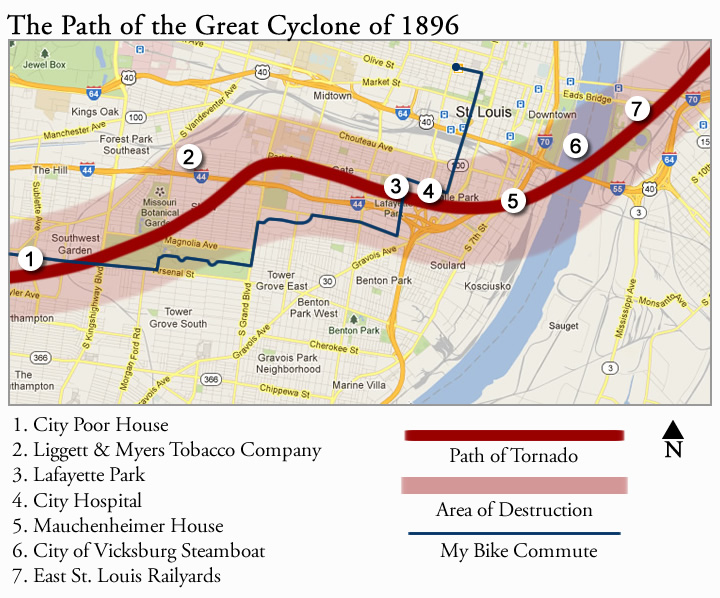
Unlike Reverend Hicks, few St. Louisans had a barometer nearby to warn them of the tornado that touched down just past 5 p.m. In twenty minutes, 255 people would be dead. Over a thousand would be injured. Over three-hundred buildings were completely destroyed while nearly eight-thousand were severely damaged. Homes were ripped from the earth, trees were uprooted, and boats were hurled across the Mississippi River. Factories, hospitals, and churches were flattened. The city’s most treasured public park would come to look like a battlefield. In just twenty minutes, St. Louis would be cut off from the rest of the world as every telegraph line out of the city would be severed.
As it headed east towards Kingshighway Boulevard, the conical shape of the tornado became more pronounced. It roared into Tower Grove Park at the south-west corner and cut across it diagonally. It stormed through Shaw’s Garden (now the Missouri Botanical Garden), uprooting hundreds of trees and plants as it moved. To the north of Tower Grove Park, the Liggett & Myers Tobacco Company was building a large addition of buildings. Ironworkers were still high atop the girders when the tornado hit, causing many to plummet and be crushed beneath fallen iron and brick.
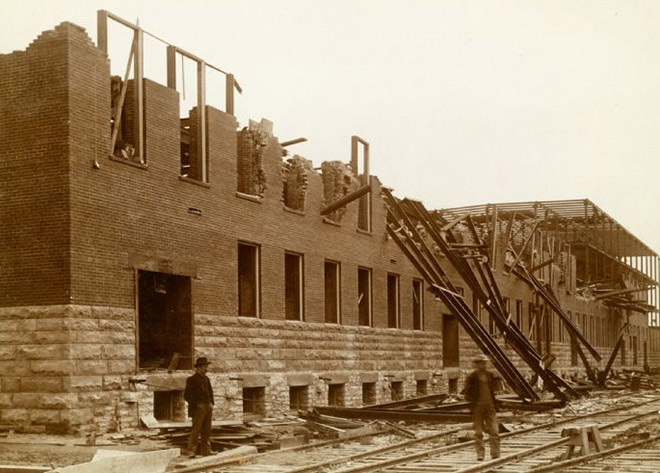
The tornado then crossed Grand Avenue and slammed into the Compton Heights neighborhood. Here it bounced around towards Jefferson Avenue, tearing off roofs, blowing out windows, and wrecking apartment buildings. The tail of the tornado snapped around in a wide arc, wreaking havoc from Chouteau Avenue to the north and Russell Boulevard to the south.
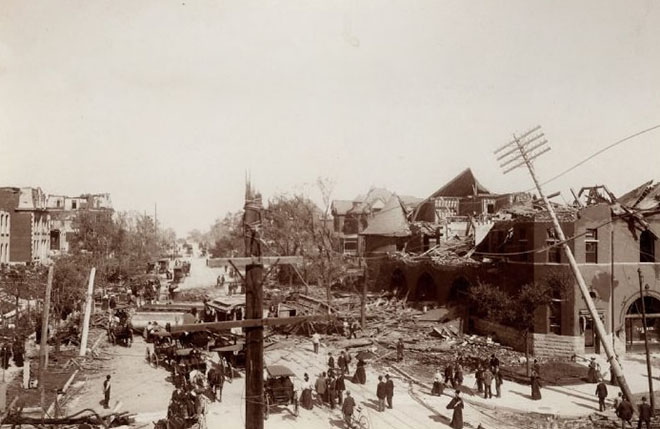
It then stormed east into Lafayette Park and the elegant homes that surrounded it. The 36 acre park was turned into “a wasteland of stripped trees and stumps.” in a matter of seconds. Gazebos and pavilions were hurled into the sky. Pieces of the main bandstand were found over four hundred yards away. Many of the stately homes and churches that surrounded the park were laid to waste.
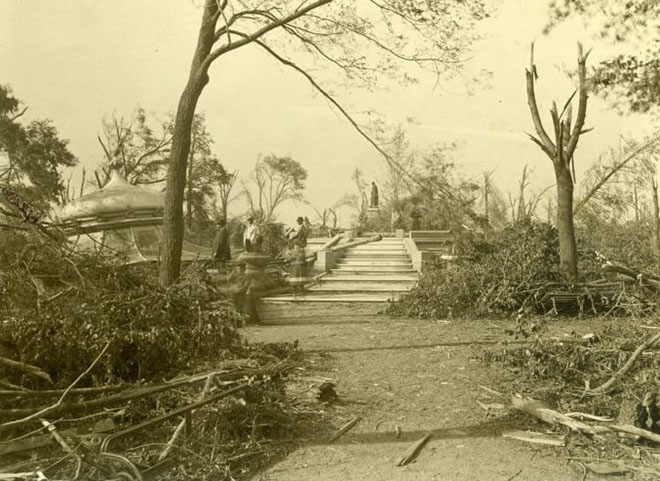
Lafayette Park was a place of beauty and joy to the residents of south city. The first public park in the city of St. Louis, its destruction delivered to them a severe blow. Surveying the damage from the balcony of his home, a Lafayette Square resident named Charles Simpson openly wept. Although his family was safe, he lamented the destruction of the park he loved dearly. He turned to his son-in-law and said “It took forty years to grow those trees, and I shall never see their like again. The house I can repair, but my trees are gone forever”.
The tornado continued east, now bearing down on the massive City Hospital complex. Containing over 400 patients, the tornado ripped roofs and floors away. The crematorium was instantly demolished. One newspaper reported that a patient named George Wilson was sucked out of his second floor room. Amazingly, he landed upright and was able to run back into the basement of the building. Another patient was pulled from his fourth floor room and thrown over 150 yards away. Miraculously, that patient also suffered only minor injuries.
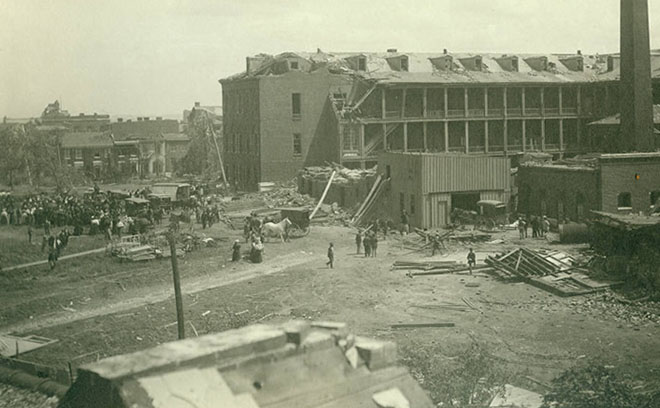
Moving past the hospital, the tornado was still gaining power. It reached its full fury in the Soulard neighborhood, near an intersection that would come to be known as the “vortex”. Here, at the corner of Seventh and Rutger Streets, a man named Frederick Mauchenheimer owned a tavern on the ground floor of a tenement building. As he sat at a table playing cards with two patrons, the tornado slammed into the building. Every floor of the building collapsed down. Mauchenheimer survived, but the other card players and fifteen others died. Six more people died across the street. The day after the storm, the body of seven-year old Ida Howell was found in the arms of her mother.
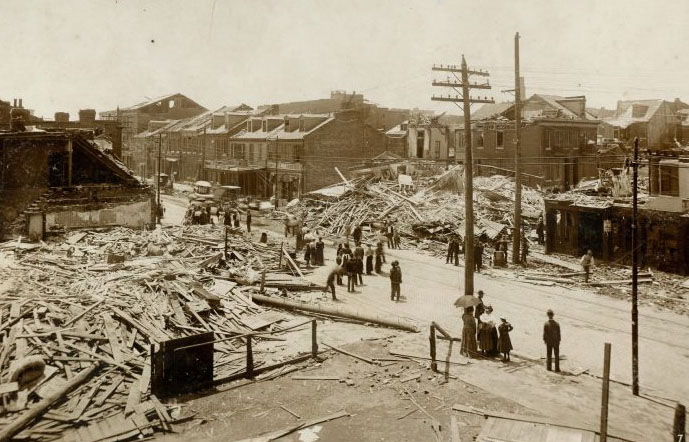
After wreaking havoc in the Soulard neighborhood, the storm turned north and continued its carnage on the riverfront. Over twenty steamboats, tug boats, and ferries were ripped from their moorings and destroyed. The steamboat “Anchor Line” was hurled across the Mississippi, crashing into pieces on the eastern shore of the river. Although the official death toll on this day is 255, many believe the number is much higher. On the riverfront, scores of people lived in shanty boats. Since their bodies were washed downriver, perhaps as many as 150 deaths were unaccounted for.
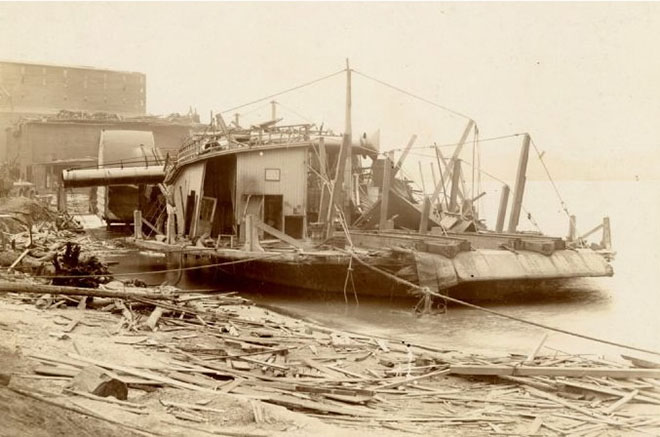
As the tornado moved across the river, even Eads Bridge wasn’t spared. The top abutment of the first pier, including the girders and rocks, was picked up and thrown onto the tracks behind a passenger train. Two baggage cars were knocked off the tracks. Wagons loaded with goods and merchandise were thrown on top of them.
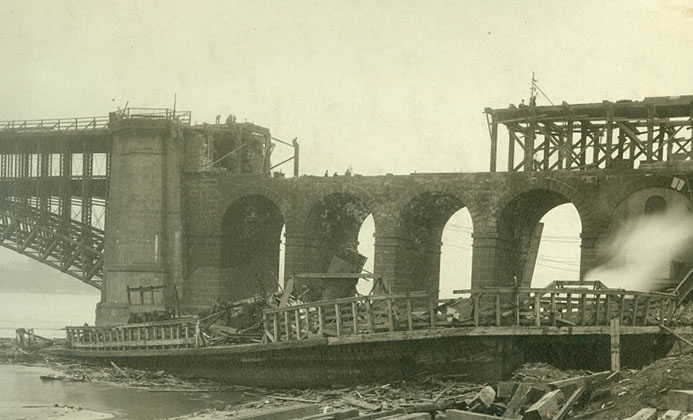
As the tornado moved onto the Illinois side of the river, residents of East St. Louis ran for cover as they watched entire homes pulled from the ground. More than 100 people on this side of the river were killed in a matter of minutes. The police station and courthouse were completely destroyed. Inside that courthouse, a jury deliberating a case barely escaped with their lives. It wasn’t until minutes before the tornado hit that the judge allowed the members of the jury to flee and find safety.
The tornado was especially deadly at the various rail yards and depots in East St. Louis. When the storm hit the St. Louis, Vandalia, and Terre Haute Railroad Depot, fifteen of the thirty-five workers were killed.
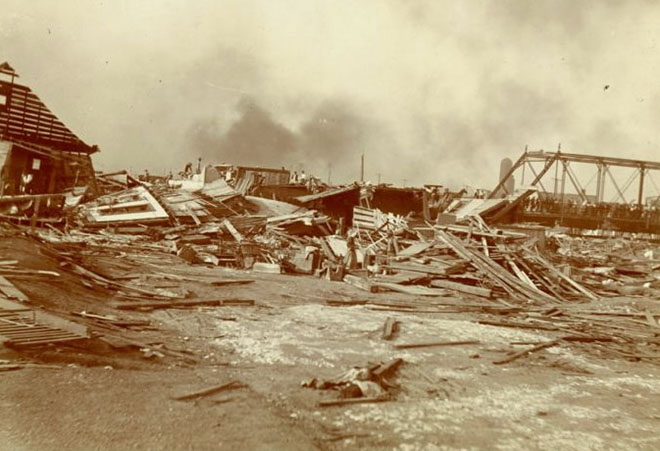
When the tornado finally dissipated, St. Louis and East St. Louis were wrecked cities. People emerged by the thousands to survey the damage and search for loved ones. Rescue efforts were organized to locate survivors buried under brick and rubble. One woman was found alive after being buried for over two days. Throughout both cities, the death toll clicked higher as victims succumbed to injuries. Many newspapers reported people physically unharmed by the storm still died of “shock”, and “fright”.
The day after the tornado, hundreds of people began gathering at city morgues to identify lost loved ones. Bodies were laid out on pine boxes as wagons departed and returned with more victims of the storm. At the St. Louis Morgue on 12th and Spruce, the crowd became so large that the police were called in to restore order.
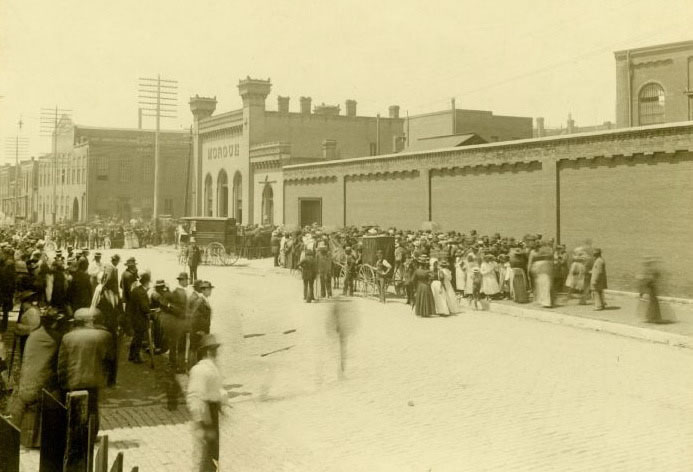
People come together in the wake of tragedy, and St. Louis in 1896 was no exception. Laborers were hired to remove debris. People who lost their homes were fed and given shelter. Communication was first restored to Kansas City, and then Chicago. Quickly, the rest of the country would come to learn about the tragedy that befell St. Louis. In the coming weeks and months, St. Louis slowly started to rebuild the homes, churches, and factories that it had lost.
Today, Lafayette Square is again one of the most beautiful neighborhoods in the city. Tower Grove Park, Compton Heights, and Shaw’s Garden look as elegant as ever. Hundreds of trees now stand tall in Lafayette Park. The City Hospital still stands as an attractive condominium complex. Although few signs of that storm are visible in St. Louis today, it’s a remarkable and tragic event in the history of the city.
![]()
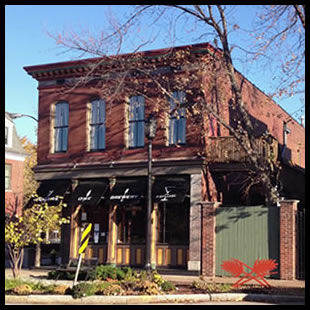
Well, this is a very depressing post to try to tie a drink to, but I’m still gonna do it. And, since that tornado cut quite a swath through St. Louis, it’s not difficult to find a bar that has ties to it. For this one, I chose Square One Brewery & Distillery in Lafayette Square. I know this place well since it’s on my bike route and the building’s previous tenant was my company’s after-work hangout years ago. Today, Square One lays claim to being the first microdistillery restaurant in the state of Missouri. They pride themselves on pairing food, beer, and spirits together. Personally, I think they do a great job because I’ve always left happy. They brew an excellent selection of craft beers in small batches that are very good. They also make a good whiskey that I’ve had on a few previous visits.
I was tempted to see what Square One would do with a Manhattan. Instead, I checked out their cocktail menu and found a drink that seemed more appropriate for the subject of this post.
The “South Sider” contains Square One’s JJ Neukomm Whiskey, a dash of bitters, and Fevertree Ginger Beer. It’s served on the rocks in a tall glass. I haven’t experimented much with mixing beer and spirits, but this was a good start. The bitters added a nice spicy flavor and I enjoyed the drink.
I asked the bartender if he knew anything about the history of the building. I was told it was built before the tornado, but he did not know the extent of damage it took. Maybe I’ll find out more on my next visit.
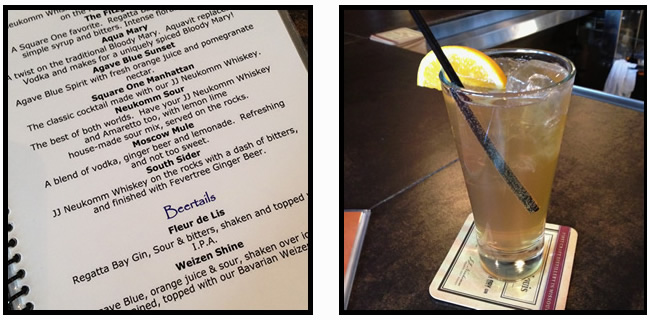

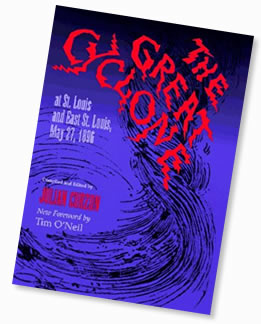
Almost all of the information for this post came from the book The Great Cyclone at St. Louis and East St. Louis, May 27, 1896. It’s a compilation of stories that appeared in St. Louis daily newspapers after the tornado hit. It was first published just days after the tornado hit in 1896. It was recently republished and a new forward was added by St. Louis Post-Dispatch writer Tim O’Neil.
All photographs used in this post are courtesy of the Missouri History Museum.

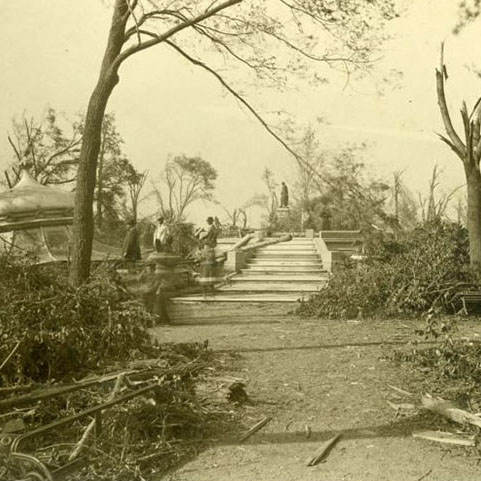
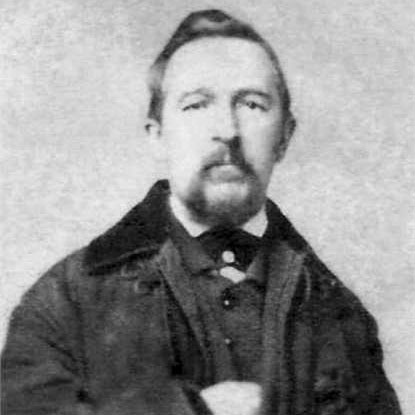
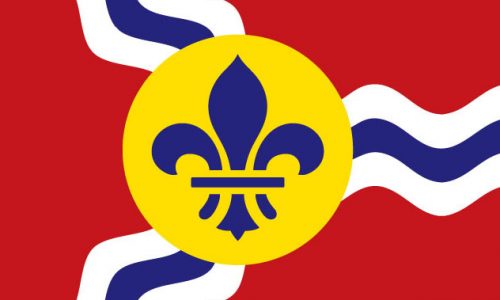
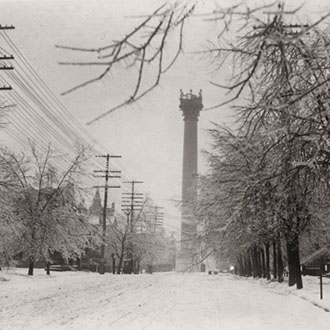
Great post! Lafayette Park is my backyard so it’s fascinating to learn the history. Cheers!
Wonderful information! Love reading more history about my city!!!
Saw a plaque in Lafayette square that mentioned the cyclone so I decided to look up details–thanks for the history
My great-grandmother survived this. From what my grandmother said, the stories she told, it sounds like my great-grandmother had PTSD for decades afterwards. Thunderstorms gave her panic attacks.
I still remember the stories my grandparents told us who survived that storm that night by the park. My grandfather was a marble cutter – stone mason that worked on the stone entrances to the park before and after the tornado. Our family has lived in Lafayette square area since 1863 and has seen many changes. Old pictures I had donated of the park to the group that takes care of it now were so excited to see horses and buck boards from the 1880 era in the park of my family having a picnic. Later years old cars lined along the fence in the 30s .40s and 50s along with pictures in the park. To the new home owners who have brought the area back keep up the good work in the neighborhood because your generation is the new door keeper of this wonderful park. This was a great story about the cyclone in 1896. God Bless